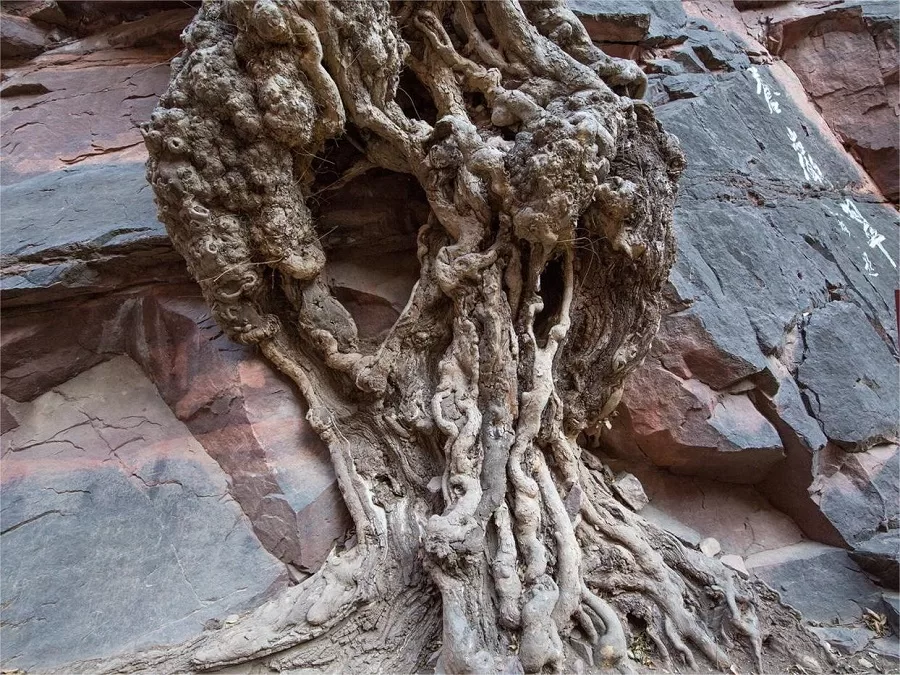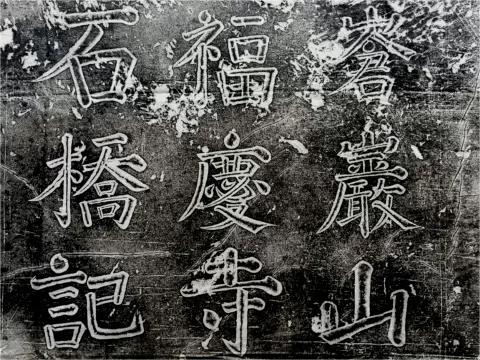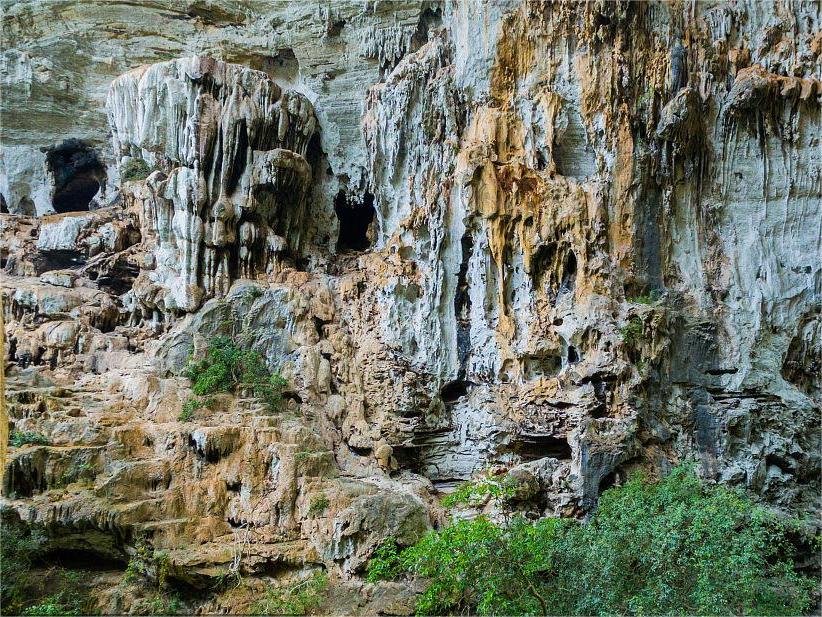Cangyan Mountain Scenic Area (苍岩山风景区), located in Shijiazhuang, spanning a total area of 63 square kilometers and rising to an elevation of 1039.6 meters, is a picturesque region nestled within the Taihang Mountain range. Characterized by stunning landscapes and lush vegetation, Cangyan Mountain boasts a diverse array of natural wonders. Amidst the undulating peaks, one can discover a multitude of ancient temples, Buddhist shrines, pavilions, and inscribed steles, most of which date back to the Ming and Qing dynasties.
These architectural marvels are strategically positioned, either perched on steep cliffs or nestled beneath precipitous cliffs, adorned with intricate carvings and preserving an ancient charm. Notable sites include Fuqing Temple, academies, Wansheng Hall, Princess Shrine, Bridge Tower Hall, Jade Emperor Peak, Peak Revolving Pavilion, and the Scripture Tower. Among them, Qiaoliang Hall in Fuqing Temple are particularly remarkable, constructed precariously on the cliffs and recognized as one of China’s “Three Hanging Monasteries”.
Table of Contents
- Basic Information
- Location and Transportation
- Highlights of Cangyan Mountain
- Video about Cangyan Mountain
- Useful Tips Summarized from Reviews
- Attractions in Suburbs of Shijiazhuang
Basic Information
| Estimated Length of Tour | About 5 hours |
| Ticket Price | 65 RMB |
| Cable Car | One-way: 26 RMB Round: 45 RMB |
| Opening Hours | 8.30 – 17.00; Last admission: 16.30 |
| Altitude | 1039.6 meters |
| Area | 63 square kilometers |
| Reputation | Four-Star Tourist Attraction Famous Historical and Cultural Mountains in China |
| Telephone Number | 0086-0311-82324104 0086-0311-82022630 0086-0311-82020448 |
Location and Transportation
Cangyan Mountain is nestled in the northeastern part of China, specifically in the Hebei Province. Situated in Jinngxing County (井陉县) approximately 50 kilometers southwest of Shijiazhuang, the capital city of Hebei, this majestic mountain is easily accessible from urban centers while retaining a sense of serene seclusion.
Tourists from Shijiazhaung can find express coaches at Xiwang Bus Station (西王汽车站). It departs at 7.00 am and 8.00 am every day. The journey takes 2 hours and costs about 30 RMB.
Highlights of Cangyan Mountain
Fuqing Temple – Temple in the Air

Fuqing Temple, a venerable site atop Cangyan Mountain, boasts a rich history spanning over 1300 years. This ancient sanctuary stands as a testament to spiritual devotion and architectural ingenuity. Its centerpiece, Qiaolou Hall, is an architectural marvel that seemingly defies gravity, spanning two cliffs with an ethereal appearance of floating mid-air. This remarkable feat of engineering and artistry has drawn awe and reverence from visitors for centuries. Fuqing Temple not only offers a glimpse into China’s religious heritage but also provides a breathtaking vantage point to admire the natural beauty of Cangyan Mountain’s surroundings, creating an unforgettable experience that marries history, culture, and stunning landscape seamlessly.
Relics of Cangshan Academy

Nestled within the serene embrace of Cangyan Mountain, the relics of Cangshan Academy exude an aura of profound history. Embraced by towering pine trees and serenaded by flowing streams, this site once thrived as a center of learning and contemplation. Regrettably, only a solitary building stands as a poignant reminder of its past glory. The remnants exude an air of nostalgia, whispering tales of scholars and seekers who once gathered here. While time has eroded the academy’s physical presence, its spiritual resonance and the natural beauty that envelopes it continue to evoke a sense of reverence and reflection.
Ancient Trees

Within the embrace of Cangyan Mountain, a captivating testament to time awaits: the ancient trees. Stoic sentinels of nature’s grandeur, some of these arboreal wonders have graced the landscape for over a millennium. Each tree narrates a unique story through its form – hollow trunks whispering secrets, skinless barks baring the passage of years, curled branches reaching for the heavens, and recumbent giants resting in tranquil repose. These arboreal elders, in their diverse postures, are living witnesses to centuries past, and their enduring presence adds a mystic allure to the mountain’s rich tapestry, inviting visitors to contemplate the passage of time and the marvels of the natural world.
Stone Steles

Scattered across Cangyan Mountain, the stone steles stand as eloquent relics of history. Crafted by the skilled hand of Qiao Yu, a distinguished Ming Dynasty official, these intricately carved monuments provide a vivid window into the past. Etched in 1527, these steles vividly detail Qiao Yu’s journey through the mountain’s landscapes, offering a succinct yet enchanting account. The calligraphy adorning them, a testament to artistry, exudes elegance and beauty. Amidst the serene surroundings, these stone steles serve as a bridge between centuries, preserving the essence of Cangyan Mountain’s beauty and history, and allowing visitors to connect with a bygone era through their eloquent inscriptions.
Beautiful Sunrise and Sunset

The Insensory Peak in Cangyan Mountain unveils a celestial spectacle where day and night embrace. At sunrise, the horizon blushes with hues of gold and vermilion, casting a warm embrace over the rugged landscape. As the sun retreats, the peak transforms into a vantage point for the breathtaking sunset. The descending sun paints the sky with a palette of oranges and purples, while shadows stretch across the land. In this dance of light and shadow, the Insensory Peak becomes a portal to ethereal moments, where nature’s artistry transcends the sensory realm, leaving an indelible mark on the hearts of those who bear witness.
Wonderful Stalagities

In the heart of Cangyan Mountain, hidden beneath its surface, lies a mesmerizing wonder: the stalactites. Formed over eons through the slow dance of water and mineral deposits, these delicate formations hang suspended from cavern ceilings like nature’s chandeliers. Adorned with intricate patterns and shimmering textures, the stalactites evoke a sense of otherworldly beauty. As visitors traverse the mountain’s subterranean realms, they are treated to a mesmerizing spectacle that whispers of time’s passage and the silent mastery of nature’s artistic craftsmanship, inviting contemplation and awe at the marvels etched in stone.
Religious Sites

Canyang Mountain boasts sacred religious sites that captivate with their rich history and spiritual aura. Among them, the Wanxian Tang, revered as the “Ten Thousand Gods Hall,” stands as a remarkable edifice embracing a multitude of Chinese folkloric deities. A sanctuary of divine presence, it reverberates with devotion and mythic resonance. Adjacent, the Qianfo Dong, or “Thousand Buddhas Cave,” weaves a tapestry of antiquity, its walls adorned with meticulously carved Buddha statues – a testament to unwavering veneration. Originating in the Northern Qi Dynasty (550-577), these sites radiate an enduring legacy of faith, offering pilgrims and visitors an extraordinary glimpse into the spiritual essence of China’s past.
Temple Festivals

Canyang Mountain’s temple festivals, a cherished tradition spanning over 1300 years, unfold in March and November of the Lunar year. Rooted in reverence for the Canyang Goddess, once a benevolent princess turned healer, these vibrant celebrations honor her legacy of curing locals with profound medical expertise post-ordination. Amidst colorful processions and spirited rituals, devotees pay homage to her, seeking blessings and healing. These biannual festivals resonate with historical significance and spiritual fervor, bridging the past and present while fostering a deep connection to Canyang Mountain’s enduring sacredness.
Video about Cangyan Mountain
Useful Tips Summarized from Reviews
Affordable and Delicious Food: The entire scenic area offers very affordable food options. At the entrance, try the 5 yuan grilled sausages and the 8 yuan cold noodles, both delicious. On the mountain, you can also enjoy noodles and other dishes, typically priced around 10 yuan.
Comfortable Summer Experience: Visiting in the summer is highly recommended for the exceptionally pleasant weather, even more comfortable than air conditioning.
Horseback Riding and Camel Photos: Near the mountain’s summit, there are opportunities for horseback riding and taking photos with camels. The cost for a photo is 15 yuan.
Coin-Wishing at Small Scenic Points: Some small scenic spots allow visitors to toss coins and make wishes. There are places where you can exchange coins for this activity.






